Wednesday, July 12th 2017

Intel Says AMD EPYC Processors "Glued-together" in Official Slide Deck
So, yes, Intel, I think the AMD engineers who have developed the Zen architecture from the ground-up would take issue with that. Especially when AMD's "Glued-together" dies actually wipe the proverbial floor with the blue company's chips in power-performance ratios, and deliver much better multi-threaded performance than Intel's offerings. Not bad for a "Glued-together" solution, I'd say.
Our resident W1zzard had this to say regarding AMD's latest CPUs: "The SenseMi power-management system seems to be working well in idle, with the 8-core machine drawing the same amount of power as Intel's quad-core "Kaby Lake" machine." And "At stock speeds, the energy-efficiency of Ryzen is truly phenomenal. Prime95 loads all cores and threads on the chip, and the Ryzen ends up with as much power draw as the quad-core Intel i7-7700K. The high power draw result of the overclocked chip is due to the increased voltage needed to achieve stable operation." And let's not forget this: This is epic. We're assuming you've sifted through our game-test results before seeing this page, and so you'll find that the gaming power draw of the 8-core Ryzen makes Intel's quad-core i7-7700K look bad. Power draw is as much as 30W lesser! Ryzen is hands down the most energy-efficient performance CPU AMD ever made, and easily outclasses Intel's 14 nm "leadership." Good show."On SMT implementation between AMD's SMT and Intel's HT, Intel is basically comparing a $2,200 8-core Xeon to AMD's usually $499 Ryzen 7 1800X. They are correct in terms of core parity there, at least, but I think it goes more against Intel's customer fleecing in core/price ratios than anything else. And it's certainly a coincidence that for Intel to achieve these SMT implementation scaling numbers, which paints them in good light, they had to down-clock the Ryzen 1800X to 2.2 GHz. So, yes. Even though independent review sites have put AMD's EPYC 7601 SMT-powered improvement in various workloads at a 24% average improvement, and Intel's Xeon 8176 falls short of that at 19.58% (even rounding AMD's score down and Intel's up, that's still how big the gap is.)Here, Intel is comparing their server-grade processors with AMD's Ryzen, desktop processors gaming woes, which really, is one of the best examples of comparing apples to oranges that I've seen in a long time. So AMD's server platform will require optimizations as well because Ryzen did, for incomparably different workloads? History does inform the future, but not to the extent that Intel is putting it here to, certainly. Putting things in the same perspective, is Intel saying that their Xeon ecosystem sees gaming-specific optimizations?Ah, the "Glued-together" dies. Let's forget how AMD's Zen cores actually look like they were architected from the get-go for modularity and scaling, which has allowed the company to keep die-sizes to a minimum and yields to a maximum. This means that from a same-sized wafer, AMD can make more Ryzen/EPYC processors (because yes, that's the beauty of it, they're almost interchangeable), and in all likelihood, have more of those full-fledged dies without any defects that affect yields.
This is one of the reasons why AMD is able to offer an unlocked, true 8-core, 16-thread CPU in the Ryzen 7 1700 at less than Intel's 4-core, 8-thread i7 7700K (which consumes more power) - but also because AMD is democratizing access to cores while Intel maximized profits at the consumer's cost for almost a decade. And Infinity Fabric, which AMD also has implemented in their Vega architecture and will probably be used for the company's Zen-based APUs and next-gen Navi graphics architecture, is only glue. Intel would certainly like to be so lucky, since AMD's Infinity Fabric actually delivers more bandwidth than their UPI (Ultra Path Interconnect.)Here, Intel are telling us how much better for the customer it is to be hard-locked to Intel's ecosystem for virtualization, since "VMs running on Intel Xeon processor compute pools can only live migrate to other Intel VM Pools". It's like they're saying "just imagine the amount of work you'll have to migrate these to AMD. Better remain with us."
Update: As some users pointed out, I used Ryzen 7 1800X power consumption figures as an example, instead of EPYC (those pictures are right here now.)However, I consider that Intel themselves opened that door when they compared their Xeon, $2,200 offering with AMD's sub $499 Ryzen 7 1800X, which isn't a server CPU (and they down-clocked it to boot, let's not forget that.) That said, for comparison and fairness purposes, I'll just leave these here, courtesy of Anandtech, comparing dual Xeon systems (E5-2699 and the new Xeon 8176) with a dual EPYC 7601 system:
Performance in POV-Ray:And maximum power consumption on the same application:So essentially, AMD has 8 more cores, 16 more threads, delivers 16% more performance than Intel's e5-2699 system and 32% more performance than Intel's "non glued-together" Xeon 8176. AMD's chip does all that while consuming 23% less power than the Xeon e5-2699, and 28% less than the Xeon 8176. Not too shabby. I'll take my CPUs with this kind of glue any day.
Check the full press slides in the source. There's an interesting read there, even if there are those chuckle-worthy Intel comments that look like grappling at straws when real arguments are absent. But hey, that's this editor's interpretation. I reserve myself the right to be wrong, and to be slightly emotional at these underhanded tactics. It's just plain disrespectful for a company which stands on its engineers' shoulders to deride another's with no compelling argument.
Sources:
Computerbase.de, Reddit, AnandTech SMT Integer Performance
Our resident W1zzard had this to say regarding AMD's latest CPUs: "The SenseMi power-management system seems to be working well in idle, with the 8-core machine drawing the same amount of power as Intel's quad-core "Kaby Lake" machine." And "At stock speeds, the energy-efficiency of Ryzen is truly phenomenal. Prime95 loads all cores and threads on the chip, and the Ryzen ends up with as much power draw as the quad-core Intel i7-7700K. The high power draw result of the overclocked chip is due to the increased voltage needed to achieve stable operation." And let's not forget this: This is epic. We're assuming you've sifted through our game-test results before seeing this page, and so you'll find that the gaming power draw of the 8-core Ryzen makes Intel's quad-core i7-7700K look bad. Power draw is as much as 30W lesser! Ryzen is hands down the most energy-efficient performance CPU AMD ever made, and easily outclasses Intel's 14 nm "leadership." Good show."On SMT implementation between AMD's SMT and Intel's HT, Intel is basically comparing a $2,200 8-core Xeon to AMD's usually $499 Ryzen 7 1800X. They are correct in terms of core parity there, at least, but I think it goes more against Intel's customer fleecing in core/price ratios than anything else. And it's certainly a coincidence that for Intel to achieve these SMT implementation scaling numbers, which paints them in good light, they had to down-clock the Ryzen 1800X to 2.2 GHz. So, yes. Even though independent review sites have put AMD's EPYC 7601 SMT-powered improvement in various workloads at a 24% average improvement, and Intel's Xeon 8176 falls short of that at 19.58% (even rounding AMD's score down and Intel's up, that's still how big the gap is.)Here, Intel is comparing their server-grade processors with AMD's Ryzen, desktop processors gaming woes, which really, is one of the best examples of comparing apples to oranges that I've seen in a long time. So AMD's server platform will require optimizations as well because Ryzen did, for incomparably different workloads? History does inform the future, but not to the extent that Intel is putting it here to, certainly. Putting things in the same perspective, is Intel saying that their Xeon ecosystem sees gaming-specific optimizations?Ah, the "Glued-together" dies. Let's forget how AMD's Zen cores actually look like they were architected from the get-go for modularity and scaling, which has allowed the company to keep die-sizes to a minimum and yields to a maximum. This means that from a same-sized wafer, AMD can make more Ryzen/EPYC processors (because yes, that's the beauty of it, they're almost interchangeable), and in all likelihood, have more of those full-fledged dies without any defects that affect yields.
This is one of the reasons why AMD is able to offer an unlocked, true 8-core, 16-thread CPU in the Ryzen 7 1700 at less than Intel's 4-core, 8-thread i7 7700K (which consumes more power) - but also because AMD is democratizing access to cores while Intel maximized profits at the consumer's cost for almost a decade. And Infinity Fabric, which AMD also has implemented in their Vega architecture and will probably be used for the company's Zen-based APUs and next-gen Navi graphics architecture, is only glue. Intel would certainly like to be so lucky, since AMD's Infinity Fabric actually delivers more bandwidth than their UPI (Ultra Path Interconnect.)Here, Intel are telling us how much better for the customer it is to be hard-locked to Intel's ecosystem for virtualization, since "VMs running on Intel Xeon processor compute pools can only live migrate to other Intel VM Pools". It's like they're saying "just imagine the amount of work you'll have to migrate these to AMD. Better remain with us."
Update: As some users pointed out, I used Ryzen 7 1800X power consumption figures as an example, instead of EPYC (those pictures are right here now.)However, I consider that Intel themselves opened that door when they compared their Xeon, $2,200 offering with AMD's sub $499 Ryzen 7 1800X, which isn't a server CPU (and they down-clocked it to boot, let's not forget that.) That said, for comparison and fairness purposes, I'll just leave these here, courtesy of Anandtech, comparing dual Xeon systems (E5-2699 and the new Xeon 8176) with a dual EPYC 7601 system:
Performance in POV-Ray:And maximum power consumption on the same application:So essentially, AMD has 8 more cores, 16 more threads, delivers 16% more performance than Intel's e5-2699 system and 32% more performance than Intel's "non glued-together" Xeon 8176. AMD's chip does all that while consuming 23% less power than the Xeon e5-2699, and 28% less than the Xeon 8176. Not too shabby. I'll take my CPUs with this kind of glue any day.
Check the full press slides in the source. There's an interesting read there, even if there are those chuckle-worthy Intel comments that look like grappling at straws when real arguments are absent. But hey, that's this editor's interpretation. I reserve myself the right to be wrong, and to be slightly emotional at these underhanded tactics. It's just plain disrespectful for a company which stands on its engineers' shoulders to deride another's with no compelling argument.


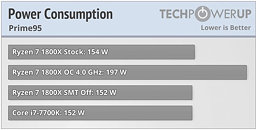
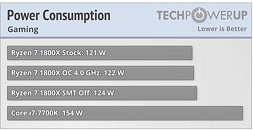
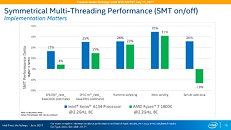
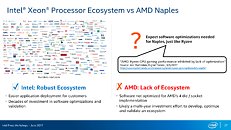
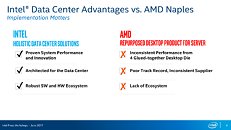
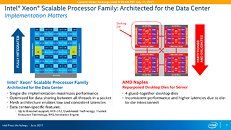
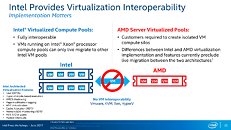
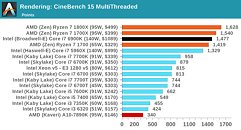
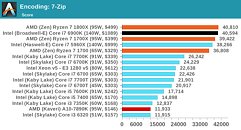
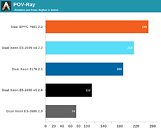

159 Comments on Intel Says AMD EPYC Processors "Glued-together" in Official Slide Deck
This is a payed advertisement for Intel!
Infinity Fabric = Gorilla Super Glue
Actually who cares what they use as long it works. And for the looks and reviews is working more than fine.
FYI ryzen's power consumption really is as good as they say, I went from a 4770K to a 8 core ryzen (4ghz) and my performance doubled in most things I do, which is about on track since a zen core is extremely close to a haswell core, but the beyond amazing thing is my power draw is the same, actually a bit lower, Haswell was 115watts, zen is 118watts, total system draw (checked on ups) when maxed out on haswell 320w total system draw with ryzen 320w, but I'm rendering 2.2x as fast!! I'm a beliber.
Any source sir ?
AFAIK AMD being sued for the fake bulldozer cores in the past by their own investors...
Source is none other than TPU.
This text is so aggresive and coarse, that if one of us wrote it on the TPU forum, it could be easily moderated.
Yet, there it is - in the news section of a renowned PC website. Why is this happening?
But nothing wrong with his statements I guess, HT indeed not a true core, CMMIIW.. where is the problem?
But when intel said EPYC was "glued", how come ?Yup, rogerthat ..
The artificial segmentation is disgusting.
At the time, it was AMD trying to fight chipzilla.
For Intel to engage in similar tactics at this time implies that they are worried about the possibility that the competition will seriously butcher their cash cow - the enterprise/server/hpc market which Intel has been able to dominate for many years.
Killing off "QPI" links on even 5xxx gold chips, killing off 1FMA AVX and limiting memory speed.
Not every workload requires 28 cores, but forcing you to buy 13k chip when a 2k one is best for your workload if they didn't artificially castrate it.
They are milking the industry.
www.anandtech.com/show/11544/intel-skylake-ep-vs-amd-epyc-7000-cpu-battle-of-the-decade/7
Check out the pricing structure.
If you want more ram, you pay for that, if you want higher ram speed you pay for that, if you want more interconnects, you pay for that.
Then you have AMD's....
If you want more cores, you pay for that. Top chip is 4k at 32c/64t.
Only want a single socket board, well we will sell you a 32c/64t chip for that too at half the price. But it still has 128 pcie lanes, 8 channels of ram at full frequency and all the features enabled through the whole line.
Use it as you see fit.